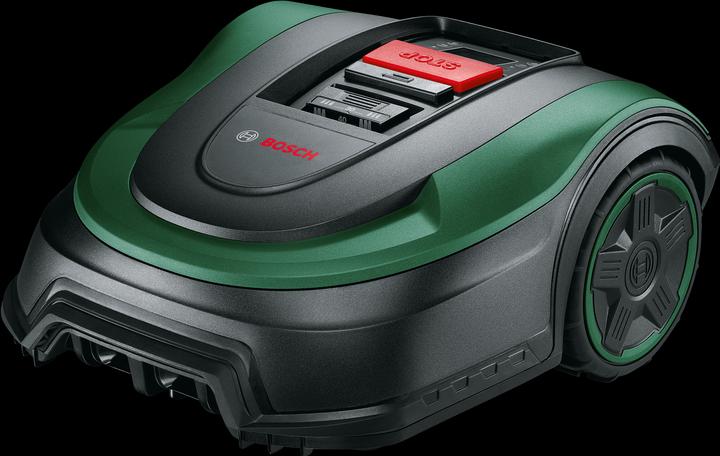

«Not through the roses!» How robotic mowers find their way around the garden
How does a robotic mower manage to trim only the lawn and leave the flowers intact? Surprisingly, the best navigational aid is a simple cable. Even better than GPS and other sensors.
How much effort does it take to lay down a cable? Armed with a Gardena Minimo and appropriate equipment, I set out in my small garden in search of answers. I also take a brief look at similar, yet differently functioning systems by the competition.
Power cable instead of light sensors
Indoors, cleaning robots use light or infrared sensors to find their way. Robotic mowers use a different technology outside: power cables that are either anchored flat to the ground with turf nails or buried a few centimetres into the ground. These so-called boundary wires are connected directly to the charging station. The cables form an electrical circuit. Thanks to a sensor, the robot detects the electrical signal through induction when passing over the cable. This signal tells him, «This far and no further!» and the robot changes direction.
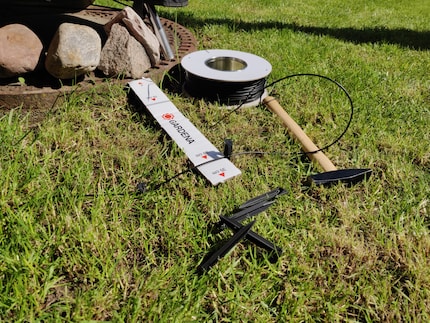

The robot travels inside the boundary wire all across the lawn. The random zig-zag pathing may cause it to mow the lawn differently, since it can’t catch all areas in one battery charge. If the robotic lawnmower drives frequently, this won’t be a problem. Taking the principle of randomness and the mathematically expected equal distribution into account, no blade of grass remains unmown. For example, the devices by Gardena and Wolf mow according to this principle.
Bosch uses a different solution for its Indego S+ 500 models. The first time it drives, it draws a map of the garden, and from then on it knows its way around. All the mowing follows the same system: first mow the entire perimeter of the garden, then the interior in parallel paths. It works similarly to how you might. It’s a bit smarter than that, though: to avoid furrows in the field, it doesn’t always take the same path.

Generally speaking, the robots reliably detect the boundary wire. But as it is with technology, something can go wrong, and the robot may leave the designated area. For example, if you have dug the cable into the ground, it may have grown deeper over time, and the signal may no longer getting through. Manufacturers advise to build a small fence around ponds or ground-level pools, despite the boundary wire. It’s better to be safe.
On my knees around the lawn
For my mini garden, it takes me about 60 minutes from unpacking to getting the robot started. And in all honesty: putting the cables into the ground is no fun, even if I only have ten square metres. YouTube videos always show happy people wiring huge gardens in no time. But the reality is that you slide around your lawn on your knees, driving a nail into the ground every ten centimetres or so. I follow the manual and measure the correct distance to the flowerbed or other obstacles every few centimetres.
Then I have a big question mark on my face: if I put down the cables 20 to 30 centimetres away from the flowerbed, will the robot not mow that area? Do I still have to cut the edge by hand?
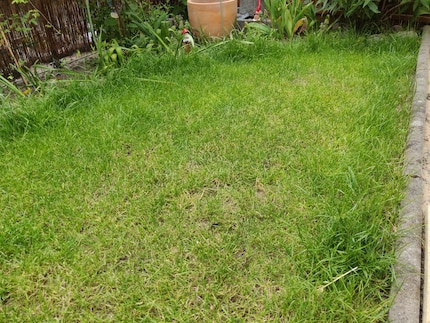
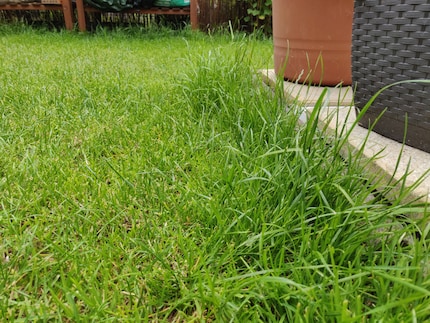
The answer is yes. Lawn edges remain. With Gardena, I can set in the Bluetooth app by how many centimetres the robot is allowed to overrun the boundary wire. However, this should be done with caution, as the robot may get stuck in the flowerbed. I have set it to ten centimetres. Nevertheless, an edge grows, as can be seen in the photos. In a garden perfect for robots, you would need to completely surround your lawn with ground-level, 30-centimetre-wide stone borders. Because the robot can drive onto these, turn around there and actually cut the grass completely to the edge.
Orientation through guide cable
After I have laid the boundary wire, more cable comes into play. The guide cable is intended to show the robot the way to the charging station when its battery level is low. To do this, it sends a different signal. The cable starts at the charging station and runs through the middle of the garden completely. It meets the boundary wire, to which it’s connected. This creates several cable paths, one left of the garden, one to the right and one in the middle. These wires guide the robot even to corners of the garden further away from the charging station.
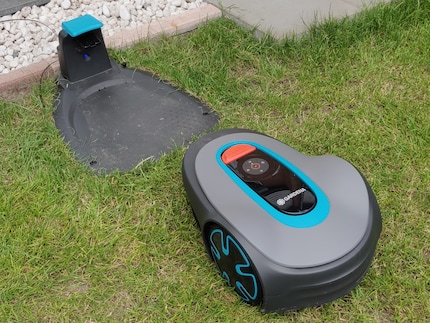
Other manufacturers use GPS systems or compass solutions for the robot’s orientation; in this case, the robot knows at all times which direction it’s travelling in and where the charging station is.
How do robots work without a boundary wire?
The most tedious work when starting up a new robotic lawnmower is definitely laying the boundary wires. It takes a long time, and mistakes are punished by the fact that you may have to re-route the entire cable again – this happened to me, of course.
For a few days everything runs perfectly. But then I find the robot in a corner of my garden with a blinking light as an error message. A look into the manual: «No signal». Nine different causes are listed for this. I go through all the manufacturer’s tips step by step, but I can’t find the problem. So I take out all the turf nails and cables and start all over again.
Putting cables into the ground is a pain, but when everything works smoothly, it’s worth the effort. I still hope that progress will ensure that future robotic mowers don’t need all the cables.
Alternatives to cables
There are already a few models that work differently. However, only for smaller gardens. Robots without boundary wires can cover up to 400 square metres. They have a lawn sensor that detects whether the area under them is grass or not. This solution isn’t perfect yet; especially grasslike areas such as flowerbeds or mulch can be driven over. The wireless robots work best when the lawn is completely surrounded by edging stones that are about ten centimetres wide.
The mowers by Wiper, Zucchetti and Ambrio fall into the category of wireless robots. IRobot also plans to introduce a cordless mower soon with the Terra T7.
An interesting device that should be available soon is Toadi. The small robot navigates via camera and uses artificial intelligence for image evaluation. It should immediately recognise new obstacles such as a ball and always know where it is. However, the technology also has its price: it’s supposed to cost around 3,000 euros or 3,300 francs.
Most of the time I'm living between bits and bytes, testing alternative Android operating systems and trying to make my life smarter with Open Source technology - always with a focus on privacy and data protection. When I'm not testing cool gadgets, I'm developing video games, writing stories and playing the accordion.
Interesting facts about products, behind-the-scenes looks at manufacturers and deep-dives on interesting people.
Show allThese articles might also interest you

Background information
Drones, robots, cameras – they all have this Swiss chip
by Lorenz Keller

Product test
Dreame A1 review: the robot lawn mower without a perimeter wire
by Lorenz Keller

Background information
Extendable arm, voice assistant, hot air: what the new robotic vacuum cleaners can do
by Lorenz Keller